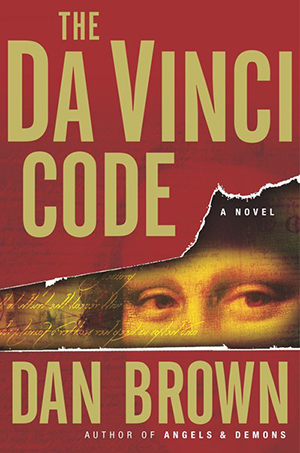 The Da Vinci Code: A Novel by Dan Brown
The Da Vinci Code: A Novel by Dan Brown Series: Robert Langdon #2
Also in this series: Angels & Demons
on March 18, 2003
Genres: Fiction / Thrillers / Suspense
Pages: 464
Format: Paperback
Source: Personal Copy

While in Paris, Harvard symbologist Robert Langdon is awakened by a phone call in the dead of the night. The elderly curator of the Louvre has been murdered inside the museum, his body covered in baffling symbols. As Langdon and gifted French cryptologist Sophie Neveu sort through the bizarre riddles, they are stunned to discover a trail of clues hidden in the works of Leonardo da Vinci—clues visible for all to see and yet ingeniously disguised by the painter.
Even more startling, the late curator was involved in the Priory of Sion, a secret society whose members included Sir Isaac Newton, Victor Hugo, and Da Vinci, and he guarded a breathtaking historical secret. Unless Langdon and Neveu can decipher the labyrinthine puzzle—while avoiding the faceless adversary who shadows their every move—the explosive, ancient truth will be lost forever.
Review
Let’s talk about the book that made conspiracy theories cool again.
Back in 2003, Dan Brown dropped The Da Vinci Code into the world like a literary hand grenade. What started as a murder mystery at the Louvre turned into something bigger: a book that had priests debating, talk show hosts, and historians pulling their hair out. At its heart, it’s a chase story. Robert Langdon, a Harvard professor who never seems to sleep, teams up with French cryptologist Sophie Neveu to crack codes that could shake the foundations of Christianity.
Here’s the thing about this book: it’s not exactly Pulitzer material. Brown writes like he’s explaining symbols to a classroom – lots of “look at this interesting fact!” moments that probably should’ve been footnotes. But damn if it doesn’t work. The pages practically turn themselves. Every chapter ends with a “just one more” hook that’ll keep you up until 3 AM, hating yourself but unable to stop.
The characters? They’re more like smart talking heads than real people. Langdon is basically Wikipedia in a Harris Tweed jacket. Sophie, at least, has some emotional stakes in the game, and watching her uncover her family’s secrets gives the story its beating heart. Then there’s Sir Leigh Teabing, who steals every scene he’s in, even if he feels a bit like he walked straight out of central casting for “Eccentric British Scholars.”
What makes this book special isn’t the writing – it’s what it did to our culture. Suddenly, everyone was an amateur historian. People were booking trips to Paris just to retrace Langdon’s steps. The Vatican didn’t just dislike this book; they acted like Brown had personally spray-painted the Sistine Chapel. It sparked the kind of debates you usually only get when someone mentions politics at Thanksgiving dinner.
Is it perfect? Not even close. The prose sometimes clunks around like a toddler in steel-toed boots. Brown never met an exposition dump he didn’t like. And if you’re a history buff, some passages might make you want to throw the book across the room.
But here’s the verdict: The Da Vinci Code is like fast food made by a chef. It’s not fine dining, but it’s addictively good, and somehow it gets you thinking about things you never considered before. It’s a beach read that accidentally started a religious debate. An airport thriller that made people question centuries of history.
Should you read it? If you like your books with a side of “what if everything you know is wrong?” then absolutely. Just remember – it’s fiction. Really entertaining, thought-provoking, can’t-put-it-down fiction.
4/5 stars – Would recommend for long flights, rainy weekends, and anyone who enjoys watching historians have meltdowns on Twitter.